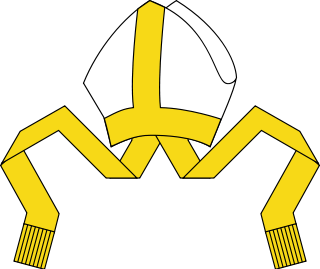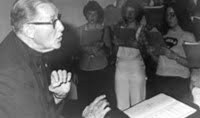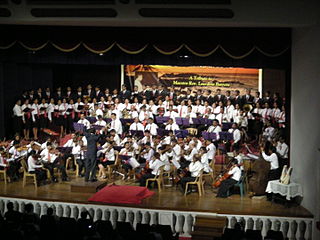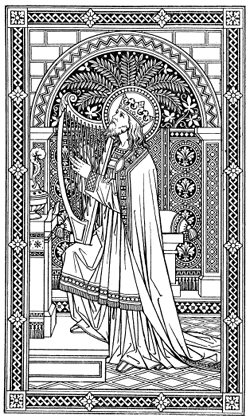
Sacrosanctum Concilium, the Constitution on the Sacred Liturgy, is one of the constitutions of the Second Vatican Council. It was approved by the assembled bishops by a vote of 2,147 to 4 and promulgated by Pope Paul VI on 4 December 1963. The main aim was to achieve greater lay participation in the Catholic Church's liturgy. The title is taken from the opening lines of the document and means "this Sacred Council".
Plainsong is a body of chants used in the liturgies of the Western Church. When referring to the term plainsong, it is those sacred pieces that are composed in Latin text. Plainsong was the exclusive form of Christian church music until the ninth century, and the introduction of polyphony

Gregorian chant is the central tradition of Western plainchant, a form of monophonic, unaccompanied sacred song in Latin of the Roman Catholic Church. Gregorian chant developed mainly in western and central Europe during the 9th and 10th centuries, with later additions and redactions. Although popular legend credits Pope Gregory I with inventing Gregorian chant, scholars believe that it arose from a later Carolingian synthesis of Roman chant and Gallican chant.

The Mass, a form of sacred musical composition, is a choral composition that sets the invariable portions of the Eucharistic liturgy to music. Most Masses are settings of the liturgy in Latin, the liturgical sacred language of the Catholic Church's Roman liturgy, but there are a significant number written in the languages of non-Catholic countries where vernacular worship has long been the norm. For example, there are many Masses written in English for the Church of England. Musical Masses take their name from the Catholic liturgy called "the Mass" as well.
William A. Jurgens was an American Roman Catholic priest, composer, historian, musician, and translator of patristic and other works.

Church music is music written for performance in church, or any musical setting of ecclesiastical liturgy, or music set to words expressing propositions of a sacred nature, such as a hymn.

In Christianity, worship is the act of attributing reverent honour and homage to God. In the New Testament, various words are used to refer to the term worship. One is proskuneo which means to bow down to God or kings.
Robert A. Skeris is an American Roman Catholic priest. He has been based in the Archdiocese of Milwaukee since 1961. He earned a Master of Arts (MA) degree in Liturgical Studies from the University of Notre Dame and studied at the Universities of Cologne and Bonn in Germany. He earned his Doctor of Theology in 1975 from the University of Bonn.

Liturgical music originated as a part of religious ceremony, and includes a number of traditions, both ancient and modern. Liturgical music is well known as a part of Catholic Mass, the Anglican Holy Communion service and Evensong, the Lutheran Divine Service, the Orthodox liturgy and other Christian services including the Divine Office. Such ceremonial music in the Judeo-Christian tradition can be traced back to both the Temple in Jerusalem and synagogue worship of the Hebrews.
St Mary's Cathedral Choir in Sydney is the oldest musical institution in Australia. In 1818 a group of choristers was formed to sing Vespers before the Blessed Sacrament in the Dempsey Household, the centre of Roman Catholic worship in Sydney as a penal colony. When St Mary's Cathedral, Sydney, was constructed, the successors of these choristers formed the Permanent Cathedral Choir under the guidance of Catherine Fitzpatrick.

Rembert George Weakland is an American Benedictine monk who served as Archbishop of Milwaukee from 1977 to 2002. Shortly before his mandatory retirement at the age of 75, it was revealed in the press that Weakland had conducted a sexual relationship with a male associate, Paul Marcoux, several decades before, and that the diocese had paid $450,000 to Marcoux to settle litigation arising from the affair.
Tra le sollecitudini was a motu proprio issued 22 November 1903 by Pope Pius X that detailed regulations for the performance of music in the Roman Catholic Church. The title is taken from the opening phrase of the document. It begins: "Among the concerns of the pastoral office, ... a leading one is without question that of maintaining and promoting the decorum of the House of God in which the august mysteries of religion are celebrated...." The regulations pointed toward more traditional music and critiqued the turn toward modern, orchestral productions at Mass.
Contemporary Catholic liturgical music encompasses a comprehensive variety of styles of music for Catholic liturgy that grew both before and after the reforms of the Second Vatican Council. The dominant style in English-speaking Canada and the United States began as Gregorian chant and folk hymns, superseded after the 1970s by a folk-based musical genre, generally acoustic and often slow in tempo, but that has evolved into a broad contemporary range of styles reflective of certain aspects of age, culture, and language. There is a marked difference between this style and those that were both common and valued in Catholic churches before Vatican II.
Scott Turkington is the organist and choirmaster for Holy Family Catholic Church in St. Louis Park, Minnesota. A native of Minneapolis, he studied music at the University of Minnesota, the Boston Conservatory of Music and The Catholic University of America, his former teachers including Richard Waggoner, Heinrich Fleischer, Phillip Steinhaus, and George Faxon.

Theodore Norbert Marier was a church musician, educator, arranger and scholar of Gregorian Chant. He founded St. Paul's Choir School in Cambridge, Massachusetts in 1963, and served as the second president of the Church Music Association of America.

Cletus Madsen was a 20th-century Catholic priest of the Diocese of Davenport in the US state of Iowa. He was involved the Liturgical Movement in the Catholic Church in the mid-20th century.

The Pontifical Institute of Sacred Music is an institution of higher education of the Roman Catholic Church specifically dedicated to the study of church music. It is based in Rome, Italy, located in the former Pontifical Abbey of St Jerome-in-the-City.

The Santa Cecilia Choir is a polyphonic male choir composed of seminarians of the Rachol Seminary of the Catholic Archdiocese of Goa and Daman in Goa, India.
The Schola Cantorum was the trained papal choir during the Middle Ages, specializing in the performance of plainchant for the purpose of rendering the music in church. In the fourth century, Pope Sylvester I was said to have inaugurated the first Schola Cantorum, but it was Pope Gregory I who established the school on a firm basis and endowed it. The choir ranged anywhere from twenty to thirty boys or men. Only the most skilled in singing were selected to participate in the Schola Cantorum.










